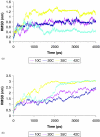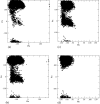On the inverse temperature transition and development of an entropic elastomeric force of the elastin mimetic peptide [LGGVG](3, 7)
- PMID: 22380064
- PMCID: PMC3306437
- DOI: 10.1063/1.3685454
On the inverse temperature transition and development of an entropic elastomeric force of the elastin mimetic peptide [LGGVG](3, 7)
Abstract
We report on a molecular dynamics simulation based study of the thermal and mechanical properties of the elastin mimetic peptide [LGGVG](n) (n = 3, 7). Our findings indicate that this peptide undergoes an inverse temperature transition as the temperature is raised from ~20 °C to 42 °C. The thermal behavior is similar to what has been observed in other well studied short mimetic peptides of elastin. Both [LGGVG](n) (n = 3, 7) peptides exhibit an increase in the number of side chain contacts and peptide-peptide hydrogen bonds when the temperature is raised from ~20 °C to 42 °C. These observations are accompanied by a decrease in the number of proximal water molecules and number of peptide-water hydrogen bonds. This work also reports on a comparison of the thermal and mechanical properties of [LGGVG](3) and [VPGVG](3) and quantifies the interaction with surrounding waters of hydration under mechanically strained conditions. It is demonstrated, via a quasi-harmonic approach, that both model peptides exhibit a reduction in the population of low-frequency modes and an increase in population of high-frequency modes upon elongation. The shift in population of frequency modes causes the peptide entropy to decrease upon elongation and is responsible for the development of an entropic force that gives rise to elasticity. These observations are in disagreement with a previously published notion that model elastin peptides, such as [VPGVG](18), increase in entropy upon elongation.
Figures







References
-
- Hoeve C. A. and Flory P. J., J. Am. Chem. Soc. 80, 6523 (1958).10.1021/ja01557a016 - DOI
Publication types
MeSH terms
Substances
Grants and funding
LinkOut - more resources
Full Text Sources

